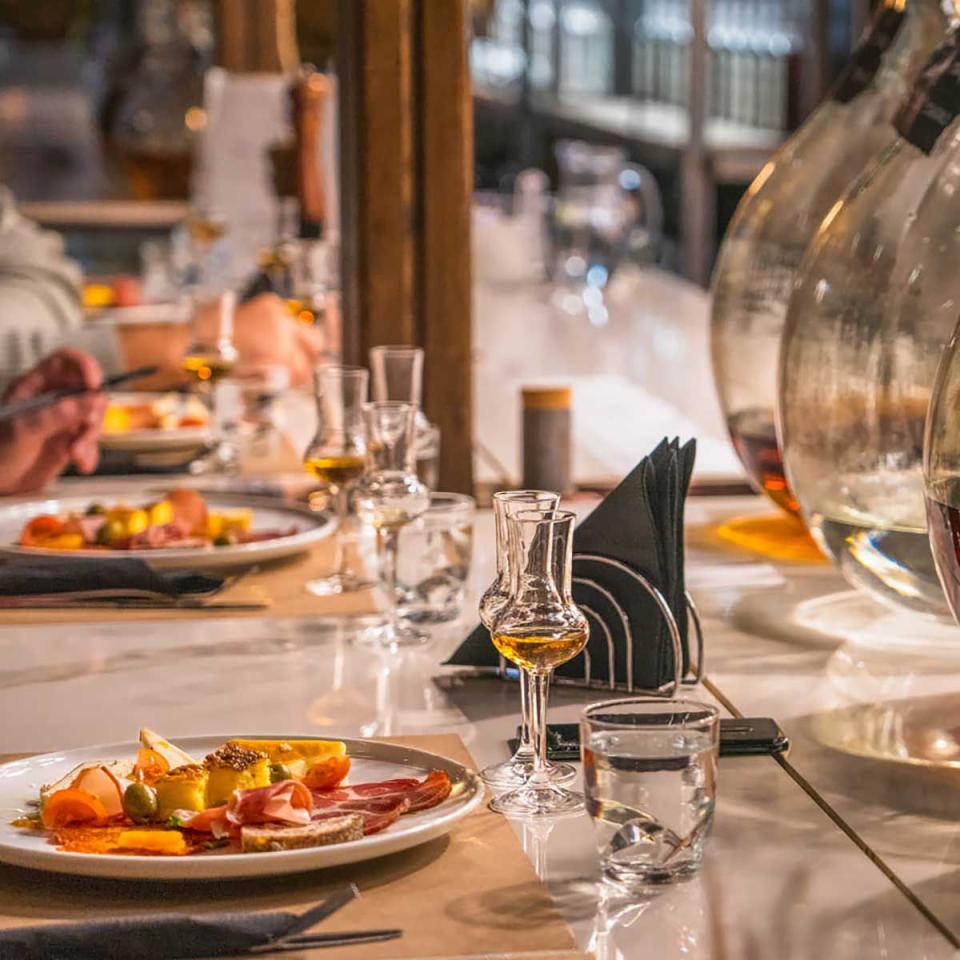Get to Know Rakia, the Spirit of the Balkans
This traditional fruit brandy is a delicious addition to your fall dinner spread.

Ivana Larrosa
RakiaMy evening at a family-run distillery located atop Goč Mountain in central Serbia was shaping up to be a decadent affair with ample amounts of high-quality rakia, a potent fruit brandy that is ubiquitous in the Balkans. Yebiga is the brainchild of Bill Gould, a rakia fanatic and bass player for the band Faith No More; He explained that his first encounter with rakia was in May 1992 at a Faith No More concert in Budapest, when some Serbian fans brought bottles to the show. Some of those bottles found their way backstage, and Gould was hooked. He began traveling throughout the Balkans, particularly Serbia, consuming more rakia — but grew frustrated that he couldn’t find any back home in California (or pretty much anywhere in the United States, for that matter). It took a couple of decades, but in 2018 Gould cemented a partnership with the Urošović family, the clan behind the respected Tok rakia.
For centuries, rakia was ubiquitous in the Balkans in the form of moonshine. The first official, legal rakia distillery, Bojkovčanka, about 10 miles south of Belgrade, was founded in 1985, with legal distilleries trickling onto the market in the following decades. By 2012, there were about 200 registered rakia distilleries in Serbia, but, an artisanal, small-batch rakia movement has emerged in the last few years. Today, there are over 800 legal, registered rakia distilleries in Serbia alone, many of which are aging the spirit in Serbian oak barrels for five, ten, or even twenty years, adding depth and flavor to the spirit, similar to the process of aged whisky. Even on my Air Serbia flight, the only direct route from the US to Serbia, the airline offers five different types of rakias from the Belgrade-based Rakia Bar.
Yebiga is part of this Serbian artisanal movement. Made on the Urošvić family farm using organic plums and the clean, crisp mountain spring water that flows down from Goč Mountain, the brand hit the U.S. market in 2021, making it the first high-quality, artisanal rakia sold in the United States.
Many of the bartenders and rakia makers I talked to in Serbia are excited about this movement to make higher-quality rakia, hoping Balkan spirit will be the next big thing in booze, the mezcal of the 2020s. Here’s everything you need to know about this potent Balkan brandy.
What Is Rakia?
Rakia, or “rakija,” as it’s spelled in various parts of the Balkans including Serbia, is a double-distilled fruit brandy. It is made almost everywhere in the Balkans, from Albania in the south to Romania and Moldova in the north. The alcohol level of most rakias is usually between 40 and 50 percent.
Don’t confuse rakia with raki, a Turkish spirit made from grapes or raisins that has an anise flavor profile, similar to ouzo in Greece or sambuca in Italy. Rakia is also not Italian grappa, which is made from the leftover grapes after wine production.
How is Rakia Made?
Rakia is distilled with local fruit, using whatever fruit in the Balkans is most present in a particular region. Along the wine-producing Dalmatian Coast in Croatia, for example, rakia takes the form of loza, a grape brandy that is made from just-plucked grapes. In Serbia, where the plum is prevalent, sljivovica, or slivovitz, is pervasive. It also happens to be the national drink of Serbia.
Rakia can also be made with quince, pear, apricot, apples, raspberries, and cherries, among other fruits. When it comes to the plum variety in particular, rakia can be unaged and transparent; When it’s barrel aged, it tends to be more flavorful, sophisticated, and smooth, reminiscent of a good cognac.
The fruit is picked and, in the case of plums, de-pitted. Sugar and yeast are added while liquid ferments in steel vats for about two to three weeks. Then the rakia is double distilled in a wood-fired copper still. After it goes back into the vats to rest for six to twelve months where it “softens” the rakia to make it more pleasant on the palate. And in many cases, there’s an extra step: aging it in Serbian oak barrels for five or more years.
How to Drink Rakia
Even though it is typically served in tulip-shaped grappa classes or shot glasses, you shouldn’t shoot rakia. This brandy is meant to be sipped, and is often served as an aperitif before meals. If the rakia is aged, let it roll around on your palate to pick up the fruit flavor, as well as the tones of the oak it was aged in. Bartenders in the increasingly great cocktail bar scene in Belgrade also mix it into cocktails. Filip Ivanović, owner/bartender of Beogradski Koktejl Klub in the Serbian capital, suggests mixing it with other spirits like gin or whiskey in order to moderate the strong taste.
If you find yourself with a full glass of rakia in front of you, raise it high and toast to your drinking companions, saying “Živeli,” pronounced “zhee-vel-ee.”
false

